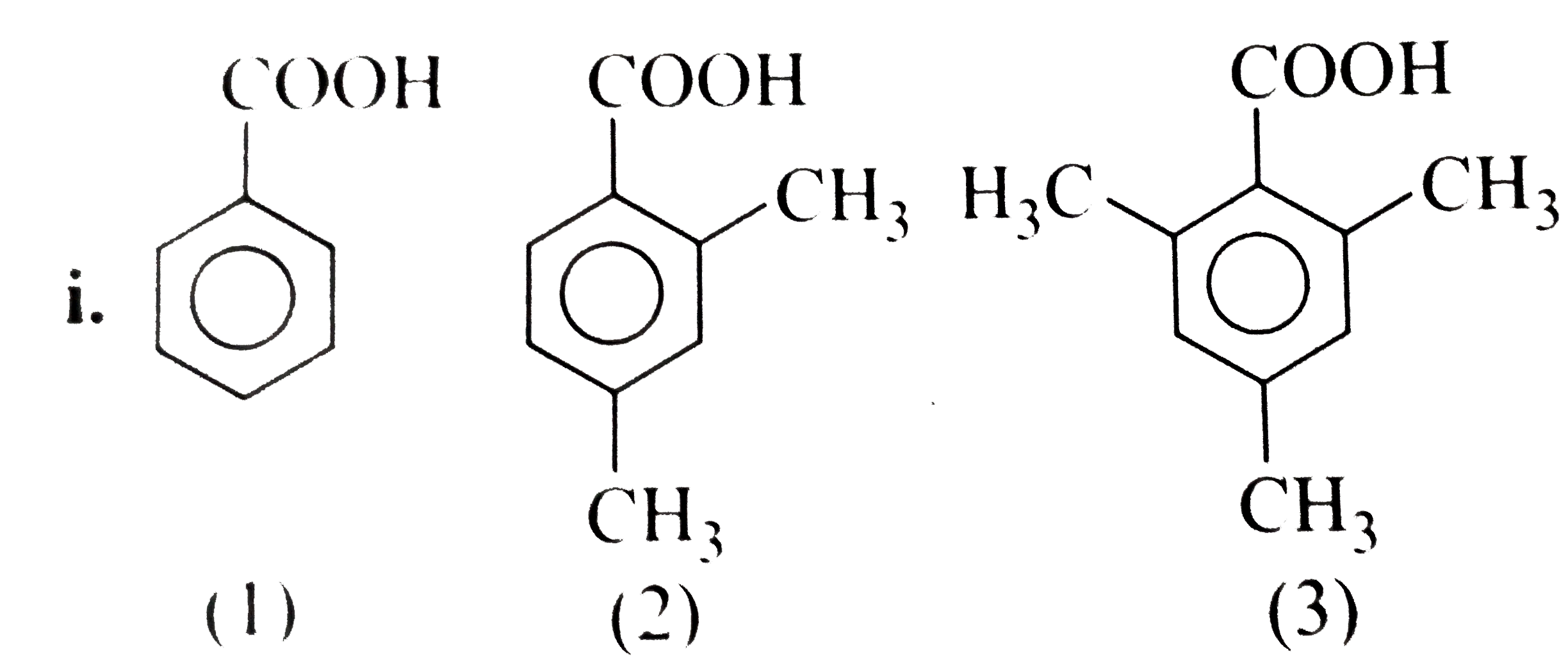What is the correct order of the rate of alkaline hydrolysis of these esters?
CH3COOCH3[rate =r1],
CH3COOC2H5[rate =r2],
CH3COOC3H7[rate =r3]
r1>r2>r3
r1<r2<r3
r1<r2>r3
r1>r2<r3
The correct Answer is:A
To determine the correct order of the rate of alkaline hydrolysis of the given esters, we need to analyze the structure of each ester and how the substituents affect the electrophilicity of the carbonyl carbon.
1. Identify the Esters: We have three esters:
- Ester 1: CH3COOCH3 (Methyl acetate)
- Ester 2: CH3COOC2H5 (Ethyl acetate)
- Ester 3: CH3COOC3H7 (Propyl acetate)
2. Understand the Mechanism: The hydrolysis of esters involves a nucleophilic attack by hydroxide ion (OH−) on the electrophilic carbonyl carbon of the ester. This leads to the formation of a tetrahedral intermediate.
3. Electrophilicity of Carbonyl Carbon: The reactivity of the ester towards hydrolysis depends on the electrophilicity of the carbonyl carbon. The more electrophilic the carbonyl carbon, the faster the hydrolysis.
4. Effect of Alkyl Groups: Alkyl groups can have an electron-donating (+I) effect, which can decrease the electrophilicity of the carbonyl carbon:
- Methyl group (CH3) has a weak +I effect.
- Ethyl group (C2H5) has a stronger +I effect than methyl.
- Propyl group (C3H7) has an even stronger +I effect than ethyl.
5. Comparing the Esters:
- Ester 1: CH3COOCH3 has two methyl groups, which exert a weak +I effect, leading to higher electrophilicity of the carbonyl carbon.
- Ester 2: CH3COOC2H5 has one ethyl and one methyl group. The ethyl group has a stronger +I effect than the methyl group, reducing the electrophilicity compared to Ester 1.
- Ester 3: CH3COOC3H7 has one propyl and one methyl group. The propyl group has the strongest +I effect, leading to the lowest electrophilicity of the carbonyl carbon among the three esters.
6. Order of Reactivity: Based on the above analysis, the order of reactivity (rate of hydrolysis) will be:
- r1>r2>r3
- Therefore, the correct order of the rate of alkaline hydrolysis is:
- CH3COOCH3(r1)>CH3COOC2H5(r2)>CH3COOC3H7(r3)
Final Answer:
The correct order of the rate of alkaline hydrolysis of these esters is:
r1>r2>r3
- Ester 1: CH3COOCH3 (Methyl acetate)
- Ester 2: CH3COOC2H5 (Ethyl acetate)
- Ester 3: CH3COOC3H7 (Propyl acetate)
- Methyl group (CH3) has a weak +I effect.
- Ethyl group (C2H5) has a stronger +I effect than methyl.
- Propyl group (C3H7) has an even stronger +I effect than ethyl.
- Ester 1: CH3COOCH3 has two methyl groups, which exert a weak +I effect, leading to higher electrophilicity of the carbonyl carbon.
- Ester 2: CH3COOC2H5 has one ethyl and one methyl group. The ethyl group has a stronger +I effect than the methyl group, reducing the electrophilicity compared to Ester 1.
- Ester 3: CH3COOC3H7 has one propyl and one methyl group. The propyl group has the strongest +I effect, leading to the lowest electrophilicity of the carbonyl carbon among the three esters.
- r1>r2>r3
- Therefore, the correct order of the rate of alkaline hydrolysis is:
- CH3COOCH3(r1)>CH3COOC2H5(r2)>CH3COOC3H7(r3)
The correct order of the rate of alkaline hydrolysis of these esters is:
r1>r2>r3
Topper's Solved these Questions
Similar Questions
Arrange the following in order of their increasing ease of hydrolysis :
CH3COOC2H5,CH3COCl,(CH3CO)2O,CH3CONH2.
View SolutionArrange the following esters in the decreasing order of alkaline hydrolysis:
(i) HCOOCH3,CH3COOCH3,(CH3)3C−COOH3,(CH3)2CHCOOCH3
(ii) CH3COOCH3,CH3COOC(CH3)3,CH3COOCH(CH3)2,CH3COOC2H5
View Solution
Knowledge Check
CH3COOH+C2H5OHX−−→CH3COOC2H5+H2O,X is
AH2SO4BNaOHCKMnO4DNiThe correct order of reactivity in hydrolysis of the following acid derivatives is
CH3COCl (I), CH3CONH2(II),
CH3COOCH3 (III), (CH3CO)2O (IV) isAI<II<III<IVBIV<III<II<ICII<III<IV<IDII<III<I<IVWhat is the correct order of equilibrium enol content of the following compounds?
(I) CH3COCH3
(II) CH3COCH2COOC2H5
(III) CH3COCH2COCH3
(IV) CH3COCH2COHAI>II>III>IVBIII>IV>II>ICIV>II>III>IDI>IV>III>II
a. Acid halides, anhydrides, esters and amides, all of them contain (C=O) group but none of them gives test for (C=O) group, i.e., they do not form oximes, hydrazones, and DNP derivatives, etc. Why?
b. Arrange the following in the decreasing order of nucleophilic addition.
i. (1)−CHO
(2)−COCH3
(3)−COOH
(4)−COCI
(5)−CONH2
(6)−COOCH3
(7)−COOΘ
ii. (1)CH3CHO
(2)CH3COCH3
(3)HCHO
(4)CH2H5CH2COCH3
iii. (1)CH3COCH3
(2)C6H5COCH3
(3)C6H5COC6H5
(4)C6H5CH2COCH3
iv. (1)C6H5CHO
(2)ρ−CH3.C6H4.CHO
(3)ρ−OH.C6H4.CHO
(4)ρ−NO2.C6H4.CHO
(5)ρ−CI.C6H4.CHO
v. (1)HCHO
(2)CH3CHO
(3)CH3COCH3
(4)CI3CCHO
c. Arrange the following in the increasing order of ease of hydrolysis.
(1)CCH3COOC2H5
(2)CH3COCI
(3)(CH3CO)2O
(4)CH3CONH2
d. Arrange the following in the increasing order of ease of acid-catalysed esterification of:
i.
ii. (1)CH3CH2COOH
(2)(CH3)2CHCOOH
(3)(CH3)3CCOOH
iii. (1)CH3CH2CH2OH
(2)CH3CHOHC2H5
(3)(CH3)2C(OH)C2H5
e. Arrange the following esters in decresing order of ease of alkaline hydrolysis.
i. (1)HCOOCH3
(2)CH3COOCH3
(3)(CH3)3CCOOCH3
(4)(CH3)2CHCOOCH3
ii. (1)CH3COOCH3
(2)CH3COOC(CH3)3
(3)CH3COOCH(CH3)2
(4)CH3COOCH2CH3
iii. (1)C6H5COOCH3
(2)ρ−CH3O−C6H4−CCOOCH3
(3)ρ−NO2−C6H4−COOCH3
(4)ρ−Cl−C6H4−COOCH3
View SolutionThe hydrolysis of ethyl acetate is a reaction of :
CH3COOC2H5+H2OH+−−→CH3COOH+C2H5OH
View SolutionWhich of the increasing order of reactivity of the following towards bease cataysed hydrolysis reaction?
(I) CH3CONH2 (II)CH3COOCh3
(III) CH3COOCh3 (IV)C_(6)H_(5) COCI
View SolutionThe hydrolysis of ethyl acetate CH3COOC2H5+H2OH+−−→CH3COOH+C2H5OH is a reaction of
View SolutionThe acidic strength of active methylene group in
I. CH3COCH2COOH2H5
II.CH3COCH2COOH3
III. C2H5OOCCH2COOC2H5
View Solution